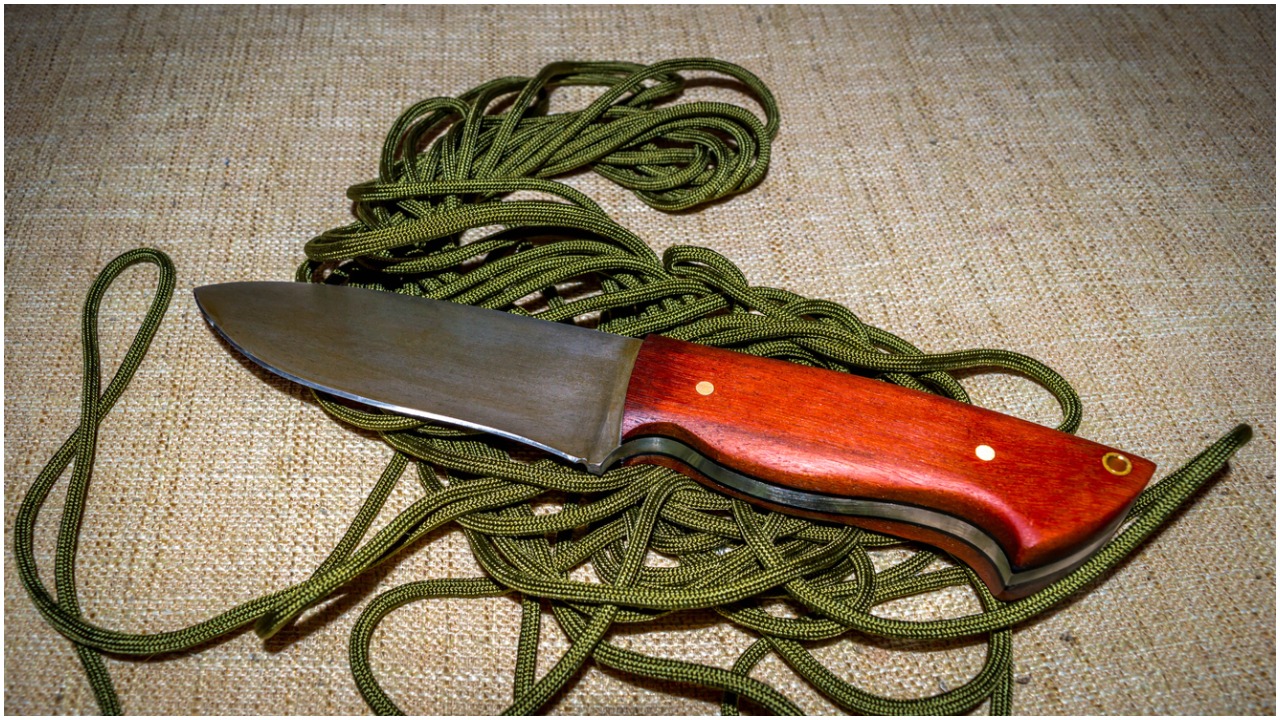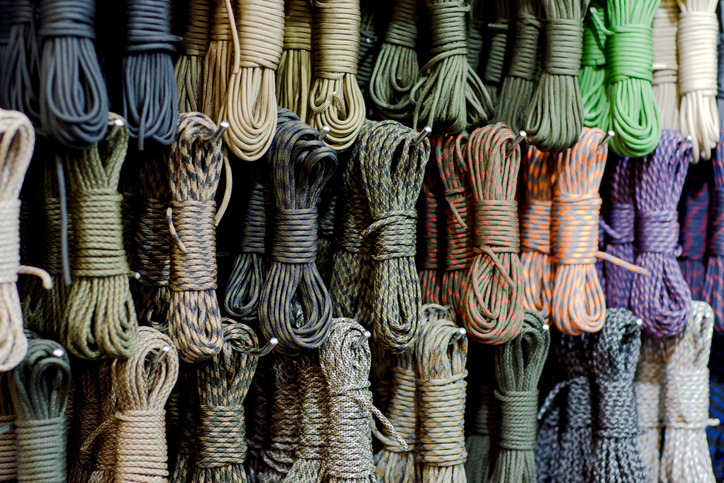Ways to Use Paracord in a Survival Situation & To Floss Your Teeth

Paracord is an amazingly useful cordage; strong, light and compact. That’s probably why it has become the cordage of choice for survivalists.
But long before any one of us thought about making a paracord survival bracelet, Airborne troopers in World War II discovered how useful it was. Our uses of this incredible cordage are merely an extension of what they started.
What we know as paracord is more correctly Type III Parachute Cord; one of six different types of cordage described in the same MILSPEC (military specification).
True paracord will have a minimum strength of 550 pounds, earning it the nickname of “550 cord.” It consists of 7 to 9 core (or kern) nylon yarns, each made of two to three nylon fibers, twisted together, with an outer braided sheath. Commercial paracord typically has a 3 millimeters (1/8”) thickness, while the true military paracord is typically 4 millimeters (5/32”) thick.

Not everything that is sold as paracord is really paracord. Originally paracord only came in Army olive drab color; but today, manufacturers produce a wide variety of colors to meet the growing consumer market.
Much of this, especially the cheaper versions, doesn’t have the 7 or 9 strand inner core, which is a dead giveaway of it not meeting the required specification for strength.
What has made paracord so popular within the survival community is the myriad of uses for this lightweight, easy to pack cordage, in a survival situation. Lets’ look at a few:
Shelter

Just about any sort of shelter you build is going to require cordage of some sort. From a lean-to to a debris hut, you have to tie the branches you are using together to make a structure. If you try to make it without tying these pieces together, it’s going to come down the first time the wind blows.
Even if you’re using a tarp for a shelter, you’re still going to need to string that tarp up, tying it to trees, regardless of what sort of tent you’re going to make out of it.
You can use your paracord to hang a tarp to make a shower, giving you a little privacy. While you’re at it, the paracord could be useful to hang a few things off of nearby trees, making your campsite a little more comfortable and homey.
And of course, you could lash a few cut off pieces of branches together, making yourself a stool to sit on.
If you’re really concerned about a lion eating you while you sleep at night, you could lash yourself into the crook of a tree with paracord, like Katniss Everdeen did in the original Hunger Games.
Food

Bears will eat just about anything, especially your lunch; for that matter, they’ll eat your breakfast and dinner too. The way to keep bears out of your food is to suspend it from a tree branch, with paracord, high enough so that they can’t reach it.
If you need to capture rainwater, you can string a tarp or survival blanket between trees with your paracord, placing it at an angle so the water will flow off one side, right into your water bottles.
Paracord is a great material for making snares with as well; either the whole cord or separating it out and using the individual strands. You can use those individual strands from the core for fishing line as well. Or, if you want to make your fishing easier, use those individual strands to make a fish trap.
Medical

Paracord can be used to make a splint, if someone breaks a bone or sprains their leg. Just tie two strong sticks to either side of the limb, using the paracord to hold the splint in place. Put some padding between the splint and the patient’s limb, so it doesn’t hurt unnecessarily.
You can also use paracord as a tourniquet. To do this, tie a loop of paracord snugly around the injured limb, as close to the body as possible.
Then put a stick under it and turn the stick, using it as a windlass to tighten the tourniquet even farther. You’ve got to get it really tight, in order to stop the flow of blood. Once you get to that point, you can tuck the end of the stick under the tourniquet to hold it.
Speaking of tourniquets, you can use paracord as a pressure bandage, placing it over the absorbent bandage and tightening it up, just like for a tourniquet. But you don’t want to tighten it as much.
On a simpler level, a loop of paracord makes a pretty good sling for an injured arm, if you don’t have a combat kravat available.
The inner strands from the paracord make pretty good dental floss.
Packing

Backpacking, hiking and survival all have much in common, including the need to carry things on your body. Lots of things can be hung around your neck on loops of paracord, like your compass, flashlight, signal mirror, whistle and just about anything else you want to makes sure you don’t lose.

If you need to pack something bigger, make yourself a pack board out of paracord and sticks. Take three sticks, about two feet long and an inch to inch and a half thick, and tie them into a triangle.
One point of this will go up, so tie loops of paracord to make arm straps. Then bundle whatever you need to carry up in a tarp or spare garment and tie it to the pack board.
If you’ve got to carry more than the pack board can handle, make yourself a travois, like the Plains Indians used to use behind their horses.
Two long poles, tied together make the runners of the travois, with a third, sorter pole, as the spreader. Smaller poles can then be tied in place, giving you a place to load your goods and tie them on. To pull it, put your head and one shoulder through the apex of the triangle.
Weapons
If you find yourself needing to make a bow while in the wild, the paracord can be used for a bowstring.
You can make a much simpler weapon out of paracord; the sling. I’m not referring to a slingshot here, but the kind that is made of a patch of leather, with two strings leading off of opposite sides. It is used by twirling the sling around your head, then releasing one string when it is pointed at the target. It takes a bit of practice, but you can actually get quite accurate with one.
For a more easily used weapon, take a knife and tie it to a straight sapling or branch with paracord to make a spear.
Oh, and if you happen to catch any bad guys, your paracord will be useful for tying them up.
Miscellaneous Camp Uses

Speaking of bows, you can use that same bow as a bow drill for starting a fire or make a smaller bow just for that.
You’re going to have to wash your clothes sometime, so it’s a good thing you have some paracord to use as a clothesline.
It is also useful as a leash for any pets that tend to wander off. Time to move and you can’t find the ties or bivvy sack for your sleeping bag? Just roll it up and tie it with a piece of paracord.
Other Emergencies
Car break down and need a tow? You can actually tow a car with paracord. Find the weight of the vehicle on the information label inside the driver’s door frame and divide it by 500.
That will tell you the number of runs of paracord you need to tie between the two vehicles, so that it will be strong enough for the tow. Just be careful to avoid any sharp edges and don’t jerk the cars when you start or you will break your paracord.
The inner fibers of the paracord make great thread for making emergency repairs to your pack and clothes. Paracord is also good for emergency repairs, such as replacing a belt that broke or the strap on a backpack.
In a real pinch, you can actually rappel down a cliff face on paracord. It’s actually strong enough for this, no matter how big you are. And if it snows, covering the ground with a nice thick blanket of white powder, that paracord can be used to make yourself a pair of snowshoes, so that you can walk out.
If, for some reason, you’re trying to move your party in the dark, tie everyone together with paracord, to keep anyone from becoming lost and separated.
